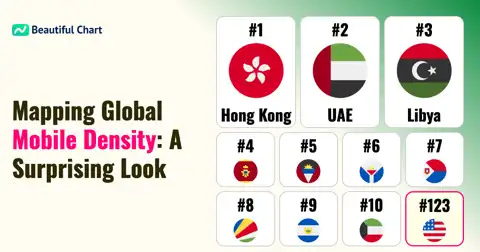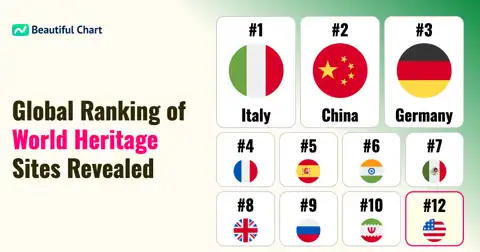This chart ranks countries based on air pollution levels, specifically the concentration of PM2.5 (measured in μg/m³), and its projected impact on life expectancy. The World Health Organization (WHO) recommends a PM2.5 guideline of 5 μg/m³, with nations like India, Pakistan, and Nepal showing levels far above this threshold. Elevated pollution correlates with a marked decrease in life expectancy, with high PM2.5 levels potentially reducing life spans by years in some areas.
PM2.5 is particulate matter with a diameter of less than 2.5 micrometers, small enough to penetrate the lungs and bloodstream, leading to severe health effects such as respiratory and cardiovascular diseases. It is a key indicator of air pollution.
The ranking of countries by PM2.5 particulate matter concentrations provides insight into how air pollution is impacting public health globally. This data set reveals that several countries, particularly in South Asia and parts of Africa, exhibit significantly high PM2.5 levels, which are well above the WHO-recommended limit of 5 μg/m³. The particulate concentration in India, which ranks highest, stands at 75.76 μg/m³, leading to an estimated life expectancy reduction of nearly seven years.
PM2.5, fine particulate matter with diameters of less than 2.5 micrometers, penetrates deeply into lung tissue, posing severe health risks including respiratory and cardiovascular issues. In regions with heavy industrial activity, vehicular emissions, and limited regulatory controls, such as India, Pakistan, and Bangladesh, PM2.5 levels remain dangerously high. These countries see life expectancy reductions of several years, underscoring the severe long-term health impacts of sustained air pollution exposure.
The chart also highlights significant disparities between countries. For example, the United States, United Kingdom, and Australia exhibit much lower PM2.5 levels, closer to WHO guidelines, with minimal effects on life expectancy. The stark contrast in pollution levels between high-ranking and lower-ranking nations points to varying degrees of industrialization, environmental regulation, and air quality management across countries. Qatar, though economically advanced, ranks high due to a distinct set of environmental conditions and heavy industry.
Understanding these rankings emphasizes the critical need for more stringent air quality regulations, cleaner energy alternatives, and pollution management strategies, especially in high-PM2.5 regions. Countries with high particulate pollution face not only immediate public health challenges but also longer-term economic and healthcare burdens as populations contend with the adverse health effects of pollution exposure over time. This analysis suggests a pressing need for a global and cooperative approach to address air pollution and its far-reaching impacts.
| Rank | Name | Indicator | Subindicator |
|---|---|---|---|
1 | 75.76 μg/m3 | Lifespan Drop - 6.93 yrs | |
2 | 55.80 μg/m3 | Lifespan Drop - 4.98 yrs | |
3 | 47.13 μg/m3 | Lifespan Drop - 4.13 yrs | |
4 | 44.17 μg/m3 | Lifespan Drop - 3.84 yrs | |
5 | 34.20 μg/m3 | Lifespan Drop - 2.86 yrs | |
6 | 32.95 μg/m3 | Lifespan Drop - 2.74 yrs | |
7 | 31.76 μg/m3 | Lifespan Drop - 2.62 yrs | |
8 | 31.63 μg/m3 | Lifespan Drop - 2.61 yrs | |
9 | 31.47 μg/m3 | Lifespan Drop - 2.59 yrs | |
10 | 31.42 μg/m3 | Lifespan Drop - 2.59 yrs | |
11 | 29.19 μg/m3 | Lifespan Drop - 2.37 yrs | |
12 | 28.71 μg/m3 | Lifespan Drop - 2.32 yrs | |
13 | 28.61 μg/m3 | Lifespan Drop - 2.31 yrs | |
14 | 28.45 μg/m3 | Lifespan Drop - 2.30 yrs | |
15 | 28 μg/m3 | Lifespan Drop - 2.25 yrs | |
16 | 27.92 μg/m3 | Lifespan Drop - 2.25 yrs | |
17 | 27.25 μg/m3 | Lifespan Drop - 2.18 yrs | |
18 | 26.91 μg/m3 | Lifespan Drop - 2.15 yrs | |
18 | 26.91 μg/m3 | Lifespan Drop - 2.15 yrs | |
20 | 25.60 μg/m3 | Lifespan Drop - 2.02 yrs |





